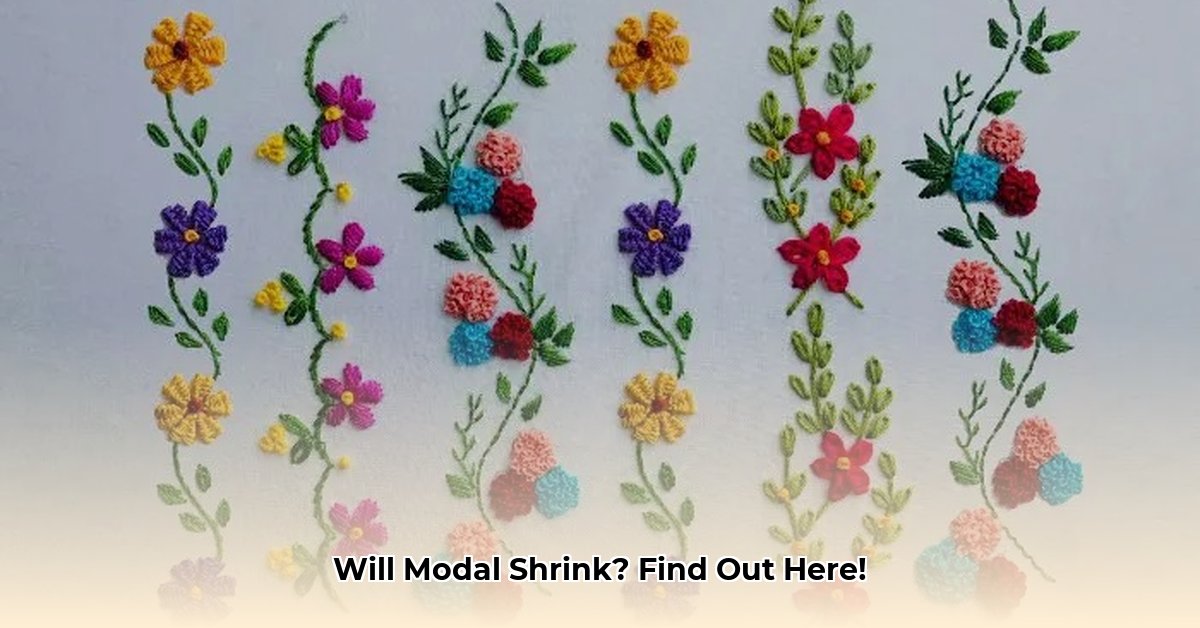So, you’ve fallen for the luxurious softness of modal fabric. But a nagging question lingers: will it shrink? The short answer is: it can. But don’t banish your modal garments to the back of your closet just yet. With the right care, you can keep them looking their best. This guide is your comprehensive resource for understanding modal shrinkage and mastering the art of washing and drying this delightful fabric.
Why Does Modal Shrink? Understanding the Science
Modal fibers are like tiny, coiled springs. Heat relaxes these springs, causing them to contract. This contraction leads to shrinkage. The hotter the temperature, the more pronounced the shrinkage. Agitation (like the tumbling in a washing machine) can exacerbate this, compacting the fibers further. High dryer heat sets this shrinkage, making it difficult to reverse. Think of it as baking a cake – once it’s baked, you can’t unbake it (easily, anyway).
Washing Modal: A Gentle Approach
Washing modal is all about being kind. Imagine hand-washing a delicate silk scarf – that’s the level of care we’re aiming for.
Step-by-Step Washing Guide:
- Check the Label: Your garment’s care label offers tailored instructions – always follow them.
- Inside Out: Turn your modal garment inside out to protect the outer surface from friction and pilling.
- Cold Water: Always use cold water (around 100°F). Hot water is shrinkage’s best friend.
- Gentle Detergent: Opt for a mild detergent designed for delicates. Harsh chemicals can weaken the fibers and increase the likelihood of shrinkage.
- Delicate Cycle: Select the gentle or delicate cycle on your washing machine to minimize agitation. Less agitation means less stress on the fibers.
Drying Modal: Air is King, Low Heat is a Distant Second
Air drying is the gold standard for modal. Lay your garment flat on a clean, dry surface or hang it on a padded hanger to dry naturally. This preserves its shape and minimizes shrinkage.
If you must use a dryer, proceed with extreme caution.
Step-by-Step Drying Guide:
- Low Heat (If Absolutely Necessary): If you can’t air dry, tumble dry on the lowest heat setting possible. A “no-heat” or “air fluff” setting is even better.
- Damp is Best: Remove the garment while it’s still slightly damp to prevent over-drying and minimize shrinkage.
- Lay Flat to Finish: Even if you tumble dry, lay the garment flat to finish drying completely. This helps maintain its shape and prevents wrinkles.
Modal Blends: A Different Ballgame
100% modal is generally less prone to shrinkage than modal blends. Other fibers in the blend, like cotton (which is known to shrink) or spandex (which resists shrinkage), react differently to heat and washing. The quality of the blend also matters. High-quality blends tend to hold their shape better. Always defer to the care label for specific instructions, as each blend has its own quirks.
Unshrinking Modal: A Difficult Feat
Unshrinking modal is challenging, but not always impossible. Gently stretching the damp fabric might relax the fibers and reverse minor shrinkage. However, there are no guarantees. The severity of the shrinkage, the fabric construction, and the specific type of modal all play a role. Some suggest soaking the shrunken garment in lukewarm water with hair conditioner, then gently stretching. Research suggests that certain fabric treatments may impact the effectiveness of this method, so results may vary.
Modal Fabric Care: Quick Reference Guide
| Task | Best Practice |
|---|---|
| Washing | Cold water, gentle cycle, mild detergent |
| Drying | Air dry (preferred), tumble dry low/no heat |
| Preventing Shrinkage | Avoid high heat, follow care label instructions |
| Unshrinking | Gently stretch while damp (results may vary) |
FAQ: Your Modal Questions, Answered
- What is modal fabric? Modal is a semi-synthetic fabric made from beech tree pulp. It’s known for its softness, drape, and breathability.
- Is modal eco-friendly? Modal is generally considered more sustainable than other fabrics like cotton, as beech trees require less water and pesticides to grow. However, the manufacturing process can still have environmental impacts. Ongoing research explores even more sustainable production methods.
- How does modal compare to viscose or rayon? Modal is a type of rayon, but it’s generally considered higher quality and more durable. It tends to pill less and hold its shape better than standard viscose rayon.
- What types of clothing are made from modal? Modal is used in a variety of clothing, including t-shirts, underwear, pajamas, dresses, and activewear.
Beyond Shrinkage: Caring for Your Modal
Preventing shrinkage is crucial, but ongoing care is equally important. Here are some additional tips to keep your modal looking its best:
- Ironing: If you need to iron modal, use a low setting and iron inside out. A pressing cloth provides extra protection.
- Storage: Fold your modal garments neatly. Avoid hanging heavy modal items, as this can cause stretching.
- Pilling: While modal is less prone to pilling than some fabrics, it can still happen over time. Use a fabric shaver or a lint roller to remove pills.
By following these guidelines and understanding the nuances of modal fabric, you can enjoy its luxurious softness for years to come. Remember, treating your modal with care is an investment in its longevity.
- Dora the Explorer Wipe-Off Fun: Safe & Mess-Free Activities for Little Explorers - April 18, 2025
- Does Lemongrass Repel Mosquitoes? Fact vs. Fiction + How to Use It - April 18, 2025
- Do Woodchucks Climb Trees?Fact vs. Fiction - April 18, 2025










